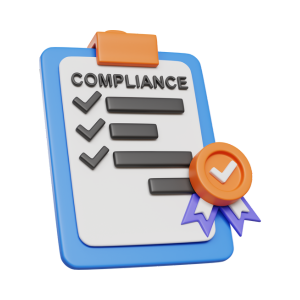Trademark Registration in India
Trademark Registration is the legal process of obtaining exclusive rights to a brand name, logo, slogan, or other identifiers used to distinguish your products or services. A registered trademark provides protection against unauthorized use and helps establish and maintain your brand’s identity in the marketplace.
- Legal Protection
- Brand Recognition
- Market Advantage
- Legal Recourse

What Is a Trademark?
A trademark is a distinctive sign or symbol used by businesses to differentiate their goods or services from others in the market. It could be a name, logo, word, design, or even a sound or smell that represents a brand. Trademark registration grants legal protection under intellectual property laws, ensuring that no one else can use a similar mark, which helps avoid confusion in the marketplace.
In India, the Trade Marks Act, 1999 governs the registration of trademarks. The Indian Trademark Office is responsible for processing applications. Upon registration, a trademark is protected for 10 years and can be renewed indefinitely.
Before filing an application, it’s important to conduct a trademark search to ensure that your brand name or logo is unique. This step prevents the rejection of your application due to similar trademarks already being registered.
Types of Trademarks in India
Trademark law in India recognizes various types of trademarks, each offering protection for different aspects of a brand’s identity. The most common types are:
- Product Mark: Used to distinguish a brand’s product from others in the market. Example: The Nike swoosh for sports shoes.
- Service Mark: Similar to a product mark but applies to services. Example: The “Uber” logo for ride-hailing services.
- Certification Mark: Indicates that a product or service meets specific standards. Example: The ISI mark for certified quality.
- Collective Mark: Used by an organization to show that its members are part of a group or association. Example: The logo used by chartered accountants in India.
- Sound Mark: Protects a unique sound that identifies the brand. Example: The Intel jingle.
- Shape Mark: Protects distinctive shapes associated with a brand. Example: The shape of Coca-Cola bottles.
- Pattern Mark: Protects a specific pattern used by a brand. Example: Louis Vuitton’s signature pattern.
- Word Mark: Protects a brand name, slogan, or phrase. Example: The wordmark for Google.
Benefits of Trademark Registration
Registering your trademark offers numerous benefits, both legal and commercial. Some of the most significant advantages include:
- Exclusive Rights: The registered trademark owner has the exclusive right to use it for their goods and services.
- Prevents Infringement: Registration allows you to take legal action against anyone attempting to use your mark without permission.
- Brand Differentiation: A trademark helps you stand out in the marketplace by making your product or service easily identifiable.
- Business Growth: As your brand grows, having a registered trademark helps protect and enhance its reputation.
- Legal Symbol: Once registered, you can use the ® symbol to indicate that your trademark is legally protected.
- Increased Value: A registered trademark can increase the market value of your business, making it more attractive to investors.
- Protection Against Counterfeiting: Trademarks can act as a deterrent to counterfeiters and prevent imitation of your goods or services.
Documents Required for Trademark Registration
To register your trademark in India, you need to submit the following documents:
Applicant’s Details
Name, address, and nationality. For businesses, include the incorporation certificate or proof of registration.
Trademark Representation
A clear image or representation of the trademark.
Description of Goods/Services
A detailed description of the goods or services your trademark will represent.
Proof of Usage
If the trademark is already in use, submit invoices, advertisements, or other documentation showing the mark’s usage.
Power of Attorney
Authorizing a representative to file the application on your behalf.
Identity Proof
PAN card, Aadhaar card, or passport for individuals; GST registration for companies.
Trademark Registration Process in India
Trademark registration in India is a straightforward process, but it requires careful attention to detail. Here’s a step-by-step guide to help you understand the procedure:
Step 1: Trademark Search
Before you apply, conduct a trademark search to check if anyone else has already registered a similar mark. This helps avoid potential rejections or legal disputes. Use online tools or seek professional help to carry out a thorough search.
Step 2: Filing the Trademark Application
Once you confirm that your trademark is available, the next step is to file an application with the Indian Trademark Office. The application will include the trademark’s details, including the mark itself, its description, and the goods or services it will represent. There are 45 different classes of goods and services, so it’s important to select the right class for your trademark.
Step 3: Examination of the Trademark Application
After filing, the Trademark Office examines the application to ensure that the trademark is not similar to any existing registered trademarks. The examiner will issue a Trademark Examination Report, highlighting any objections. If objections arise, you’ll need to respond and potentially amend your application.
Step 4: Publication in the Trademark Journal
If the application passes examination, it is published in the Trademark Journal. This allows other parties to raise objections. If no objections are filed within four months, the trademark will proceed to registration.
Step 5: Trademark Registration
If there are no objections or if any objections are resolved in your favour, the trademark is registered, and you will receive a Trademark Registration Certificate. This confirms that you have exclusive rights to use the trademark for the specified goods or services.
Trademark Symbols: TM, ®, and ℠
Once you begin using a trademark, it’s essential to understand the symbols that indicate its status:
- TM Symbol (™): The TM symbol signifies that a brand is claimed by its owner, even though the trademark is not yet registered. It provides a degree of protection, helping establish ownership rights in cases of brand disputes or infringement. This symbol can be used on any unregistered trademark.
- R Symbol (®): The ® symbol indicates that a trademark is officially registered with the relevant trademark authority. Once your trademark is registered, you are entitled to use the ® symbol, which provides full legal protection against unauthorized use of your trademark in connection with specific goods or services.
- SM Symbol (℠): The SM symbol is used for service marks to represent services, even if they are not yet registered. Like the TM symbol, it helps claim ownership of a brand related to services, offering a basic level of protection.
Importance of Trademark Registration
Trademark registration offers several advantages for businesses, ranging from legal protection to increasing brand value. Here are the key reasons why you should register your trademark:
- Legal Protection: Registration grants you exclusive rights to your trademark, protecting it from unauthorized use.
- Builds Brand Trust: Customers trust brands that are protected by trademarks, as they signify reliability and consistency.
- Avoids Legal Conflicts: By registering your trademark, you protect your brand from competitors or others who may try to copy or infringe upon your identity.
- Creates an Asset: A trademark is an intangible asset that can enhance the overall value of your business.
- International Protection: Through the Madrid Protocol, you can extend your trademark protection to other countries, making it a global asset.
Trademark Renewal
A registered trademark is valid for 10 years. To maintain protection, you must renew it before the expiration of this period. The renewal fee for a single class is ₹9,000, and there is an additional fee if renewal occurs within six months of expiry. Failing to renew your trademark could lead to loss of protection, and your trademark may be removed from the register.
Conclusion
Trademark registration is an essential step in protecting your brand and building your business. It grants legal protection, helps you avoid disputes, and enhances your brand’s reputation. By registering your trademark in India, you secure exclusive rights to your mark, ensuring that your business remains distinct and protected in the marketplace. With proper documentation and a clear understanding of the process, businesses can safeguard their intellectual property and reap the benefits of trademark protection for years to come.
Get A Free Consultation
FAQ'S
A trademark is a symbol, word, or design that distinguishes your goods or services from others. Registering a trademark protects your brand, prevents others from using similar marks, and provides legal recourse in case of infringement.
Trademark registration provides legal protection, exclusive rights to use the mark, the ability to sue for damages in case of infringement, and enhances brand reputation. It also adds value to your business and allows you to use the ® symbol.
Conduct a trademark search using databases like the USPTO’s Trademark Electronic Search System (TESS) to check for existing marks that are similar or identical to yours.
The process includes conducting a trademark search, preparing and filing an application, undergoing examination by the trademark office, publication for opposition, and receiving registration if no oppositions arise.
Trademark registration typically takes between 6 to 12 months from the filing date, depending on jurisdiction and whether there are any complications or oppositions.
You need the applicant’s details, a clear representation of the trademark, a description of the associated goods or services, and the basis for filing (e.g., use in commerce or intent to use).
Costs include application fees, potential attorney fees, and additional fees for international registration or extending the trademark to other classes.
Yes, international registration can be pursued through systems like the Madrid Protocol, which allows for registration in multiple countries with a single application.
You can take legal action by sending a cease-and-desist letter, negotiating a settlement, or filing a lawsuit to enforce your rights and prevent further infringement.
Trademark protection generally lasts for 10 years and can be renewed indefinitely. To maintain it, you must use the trademark consistently, renew the registration on time, and monitor for potential infringements.








